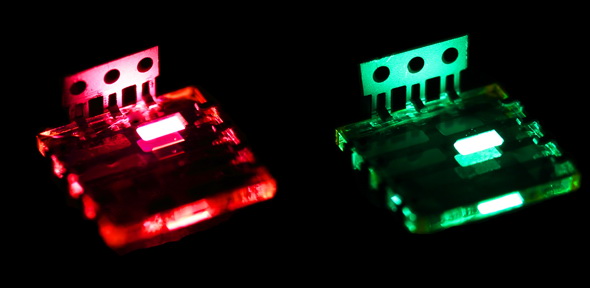Display Components – I was browsing through an article at Laser Focus World (LFW) titled “Technology Review: Top 20 technologies for 2014 cover the range from basic R&D to new apps” by LFW Senior Editor John Wallace.
Not all of these top-20 technologies will have a direct impact on the next generation of displays, but a surprising number of the 20 he discusses will. These technologies include:
#1 Augmented-reality displays. Wallace uses as an example a near-the-eye display jointly developed by the University of North Carolina at Chapel Hill and NVIDA and presented as a paper at the SIGGRAPH conference this summer. This see-through display creates virtual images using an array of small light sources called pinlights to backlight a spatial light modulator, i.e. a transmissive LCD. These are in different planes which are both so close to the eye as to be out of focus. They work together in a way very similar to a light field display to present a transparent and in-focus image at a distance from the viewer. The authors, with PhD candidate Andrew Maimone as lead author, call the image generation technology “Coded Projection,” not light field display, but the mathematics of generating the image is similar. The complete SIGGRAPH paper can be downloaded at Maimone’s website. Oh, by the way, you can download his CV as well, if you’re looking for a new hire. A video explaining this technology is on YouTube and posted below.
 Augmented reality NTE display from UNC and NVIDIA. A) A sparse array of point light sources, called pinlights, fill the eye’s image plane when held defocused near the eye. B) Prototype optical see-through display consisting of pinlight arrays and spatial light modulators (LCDs). The spatial light modulators code the defocused pinlights to form an image on the retina. C) A photograph taken through our prototype display using a camera that approximates the human eye. D) A comparison of the field of view of the prototype display (110°) to state-of-the art commercial optical see-through glasses. Ship model by Staffan Norling.
Augmented reality NTE display from UNC and NVIDIA. A) A sparse array of point light sources, called pinlights, fill the eye’s image plane when held defocused near the eye. B) Prototype optical see-through display consisting of pinlight arrays and spatial light modulators (LCDs). The spatial light modulators code the defocused pinlights to form an image on the retina. C) A photograph taken through our prototype display using a camera that approximates the human eye. D) A comparison of the field of view of the prototype display (110°) to state-of-the art commercial optical see-through glasses. Ship model by Staffan Norling.
#4 Negative-index layers in thin-film coatings. Projectors, NTE displays, HUDs and other display technologies use a lot of multilayer thin film coatings. Typically, designers are limited to positive values for indices of refraction, since real materials only have positive values. With metamaterials, it is possible to have negative indices of refraction in your design. This is likely to help especially in the design of color selective filters and possibly in polarizing filters.
#6. Visible tunable fiber lasers. Researchers at Lockheed Martin Laser and Sensor Systems (formerly Aculight) have developed tunable lasers that will output IR, red and green light. Add a GaN blue laser and this might prove useful in a simulator where you want full color images with night vision IR added.
#7. Blue-emitting VCSELs. Vertical-cavity surface-emitting lasers (VCSELs) based on GaN are a topic of research at Nichia (Anan, Japan), Panasonic (Osaka, Japan) and other places. Current VCSELs, such as the ones used by NECSEL Technologies, are in the red and IR region. These are good for frequency doubling to produce blue and green light and they are reportedly used in both IMAX and Dolby Cinema laser projectors. Still, it would be nice to have direct emission blue and green VCSELs to replace the frequency doubled ones.

Red and green LEDs based on perovskite materials from the University of Cambridge.
#9 & 10. Perovskite VCSELs and high-brightness LEDs. Perovskite is not a single material, but a class of metamaterials. These materials have several very good properties: (1) fabrication is cheap and easy, (2) they can have very high quantum efficiencies when used in LEDs and lasers and (3) they can tolerate high current densities. This could lead to low-cost, high efficiency LEDs and lasers. LFW’s Wallace thought perovskite materials were so important he gave them two positons on his top 20 list. In addition to Lasers and LEDs, perovskite materials can be used in high-efficiency solar cells, where the low cost and ease of manufacturing would be more important than their high efficiency. Researchers from the University of Cambridge (Cambridge, England), Ludwig-Maximilians-Universität München (München, Germany), and the University of Oxford (Oxford, England), among others, are working on these materials.
#18. Quantum-dot LCDs. Display Central readers hardly need to be told about the increased color gamut possible if quantum dot (QD) backlights are used with LCD displays, compared to conventional LED or CCFL backlights. If you’ve forgotten, just watch the Display Daily interview with QD Vision’s Matt Mazzuchi done at IFA in September.
So there you have it, seven out of 20 hard-core optical developments have direct application to displays. Several other items on the list, such as #11 Orbital-angular-momentum multiplexing can increase communication bandwidths. Display users seem to have an unlimited desire for bandwidth, so anything to increase it is a good thing.
Except for the NTE display from UNC and NVIDIA and the QD backlights from a variety of vendors, none of these technologies is likely to influence display design in the next year or so. But, after that, who knows? – Matthew Brennesholtz

